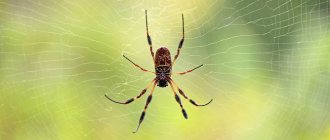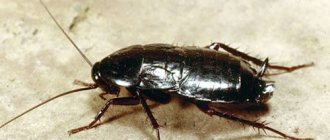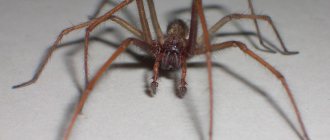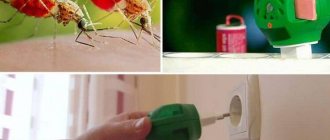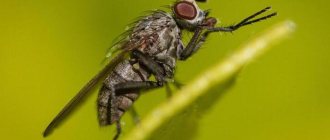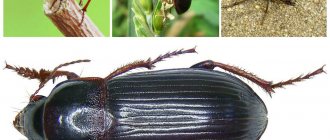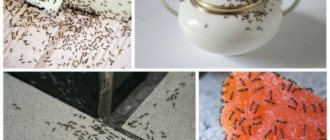What does a centipede look like?
Contrary to the prevailing opinion of people who are not very knowledgeable in biology, the centipede is not an insect. This creature is a representative of the class Lipopods from the numerous superclass Centipedes. The length of this arthropod usually does not exceed 35-70 mm, although larger individuals are also found (up to 100-120 mm). The body is very inconspicuous, dirty brown or grayish-yellowish in color, with bluish or violet-reddish longitudinal stripes and striped legs.
Important! Accidentally damaged or lost centipede limbs are restored and grow back.
The body, covered with a chitinous shell, is composed of 15 segments, each of which has its own pair of paws. In this case, the first pair is a very specific type of jaw, used for capturing prey, and also, if necessary, for protection. The very last pair of legs of this arthropod is distinguished by its increased length (sometimes twice as long as the entire body) and looks more like a mustache. Sometimes it is impossible to understand where a centipede's head is, because the real tactile whiskers and hind legs are surprisingly similar.
Short description
In appearance, centipedes resemble worms that have grown many limbs. The body length, depending on the species, reaches 100 mm. The first pair of legs is equipped with pincers, with the help of which the insect captures and holds prey. On each subsequent pair of legs there is 1 thorn, which is saturated with poison.
Body color also depends on the species and can be light or brown. The body is divided into many segments, which is why centipedes are so nimble and mobile. To feed, insects go to damp places during the dark period of the day. In nature, they live in fallen leaves, grass or any other plant or industrial debris.
Factors that attract scolopendra
The possibility of appearing in a private house or apartment is influenced by a number of conditions:
- The main reason is the increased level of humidity in the house. This atmosphere will definitely attract centipedes.
- Nutrient residues. It has been noticed that centipedes appear faster in houses with messy tenants or in a dormitory than in a neat housewife.
- A warm, comfortable atmosphere combined with humidity creates a steam room effect that attracts pests.
The first places in the house that centipedes begin to inhabit are the bathroom, bathhouse or toilet. Insects cannot get in if the ventilation grilles and windows are covered with mosquito nets.
The danger of proximity to scolopendras
The flycatcher is absolutely harmless to humans, but the venom of the scolopendra can cause redness at the site of the bite, swelling and burning. Negative consequences disappear only after 24-48 hours.
Signs if there is a centipede in the apartment
In natural wild conditions, centipedes live under stones, in grass, under bushes and trees, under last year's fallen leaves, preferring to settle on the shady side. For the winter, they look for secluded corners and, having settled there, hibernate. With the arrival of warm spring days, they become active again and crawl out to freedom. Sometimes in the fall, after a cold snap, arthropods come to human dwellings in search of shelter, where they choose damp and damp places (cellars, basements, bathrooms, toilets, etc.).
The most famous folk superstition says that seeing a centipede at home is not at all dangerous. Its appearance foreshadows the receipt of some news or news coming from afar. Moreover, all this is given a favorable meaning; the news will be positive. However, believers and pious people preferred to see the negative side of the sign about centipedes, associating their presence with cleaning done at the wrong time (on Sunday or on a holiday). This is what the negligent housewife was accused of.
Since centipedes love high humidity and dampness, most likely their appearance in the house signals freezing and moldy corners, poorly adjusted windows, problems with the plumbing (pipes or any plumbing fixtures are leaking) and other troubles. And the point here is not at all about signs, but about the need to immediately correct the situation.
Important! For the purpose of self-defense, a centipede can bite quite noticeably, releasing toxic venom, but it is not dangerous for humans or pets (unless there is an allergy). In addition, the arthropod is not able to bite through the skin; it only bites lightly.
Arthropods can easily run along walls
Where do small white insects come from in the bathroom?
For people faced with such a problem, the first thing that worries them is the question of where these domestic insects come from.
First of all, it’s worth figuring out what attracts them to the bathroom:
- This is exactly the place where there is increased dampness. For white bugs, such an environment is favorable. In it they can fully exist, feed and reproduce.
- In the bathroom, insects will always find water and food for themselves.
- This is the part of the room where there are almost always no people who can scare you.
- Daylight is an unfavorable area for bugs; they feel more comfortable in the dark.
- Another reason to stay in this place is that there are no pets.
Based on the above factors, we can safely say that the bathtub is the most favorable place for white ill-wishers to live.
Now it’s worth figuring out where they come from into the house. First of all, they can immigrate from basements, attics or neighbors. Not surprisingly, people living on the first or last floor often face this problem. They can also develop independently within the walls of an apartment from larvae.
There are several reasons why they may appear:
- extreme pollution;
- excessive humidity and wet pipes;
- increased air temperature.
To ensure that you never have a problem like insects in your apartment, you should always keep your bathroom completely clean.
Signs if you kill a centipede
Unlike many species of insects that live next to people in their homes, centipedes bring very tangible benefits. Being predators, they methodically catch and destroy flies, fleas, crickets, bedbugs, cockroaches, spiders, moths and other pests. Arthropods perfectly see, smell, and also focus on vibrations produced by potential prey. They attack with lightning speed, injecting paralyzing poison, and then eat their prey.
A folk sign associated with centipedes states that under no circumstances should one kill the messenger who brought good news to the house. There are no serious consequences after this act, but, to say the least, it is ugly. From a practical point of view, getting rid of centipedes is illogical, since the voracious arthropods are very successful, completely free and safe (using environmentally friendly methods) in helping to get rid of household pests.
Comment! A centipede seen in a dream foreshadows small but troublesome matters that require a lot of effort and time.
Centipedes happily feed on their close relatives - other arthropods
How to get rid of centipedes?
On the site we answered the question of how to get rid of woodlice in an apartment. Centipedes are similar to woodlice. Currently, there are a large number of methods that are aimed at getting rid of this pest.
Most of them will not bring any benefit, in particular, we are talking about Velcro. They can only be used against flies; nothing will work with a centipede. She will just run along the tape and that’s it.
As for baits, they are also ineffective. After all, the centipede loves to eat insects; it does not perceive other odors.
Features of getting rid of centipedes:
- The first and most effective method is to completely get rid of the centipede’s food. That is, you need to make sure that there are no cockroaches, termites and spiders in your house. You can use a lot of tools for this.
- If you live in a house, you need to thoroughly clean the area around the building, remove old leaves, grass clippings and debris.
- Also clean the bathroom and carry out cosmetic repairs if necessary. Make sure that no puddles form near the pipes. After all, millipedes love a humid environment, so you should remember this.
- Don't forget about the ventilation holes. They must be closed. All cracks must be of a certain size so that the centipede cannot enter the room. Regularly treat the mesh with insect repellent spray.
- You should also seal all cracks in walls and windows to prevent insects from crawling from your neighbors.
Chemicals
In addition to standard methods, there are also chemical means. They should be used as a last resort if all else helps.
The chemical itself has a powder base; it must be prepared following the instructions. Then apply to the places where the centipede most often appears: the area under the bathtub, near the pipe, cracks.
Here are a few remedies:
- Diatomaceous earth in powder form. Its grains have rather sharp edges, which negatively affects insects. The pest just needs to walk through the substance and that’s it, the injury is guaranteed. Over time, the body will simply become dehydrated;
- All kinds of insecticide concentrates are the most effective means that can rid a person of a centipede once and for all. After treating the surface, small capsules with poison remain on it. They stick to insects and kill them;
- Gels – after contact with an insect’s legs, the process of cell necrosis occurs;
- Paste with deltamethrin - there is almost no smell, after contact with an insect it causes a lot of unpleasant sensations. After just a few days, the centipede will leave the house for a long time.
As for a private home, pests enter exclusively through windows. It is necessary to treat the lower part of the structure with an insecticide. It is suitable for outdoor use. It should be remembered that the width of the wall being processed must exceed 150 centimeters.
To eliminate centipedes in the yard, it is necessary to treat the paths and building materials located on the street.
This type of product should not be used near children or pets. They must be removed during processing to prevent unpleasant consequences. These include an allergic reaction and the appearance of a skin rash.
What to do with a centipede in the house
Centipedes are most active in the dark, so quite often owners are not even aware of their presence. However, they can move around the apartment during the day, extremely frightening and unnerving household members. You can accept their presence, or you can simply carefully catch the arthropod and release it outside, choosing a damp area if possible.
When there are too many centipedes in the house, then, according to the superstition, it is enough to catch and throw out only one individual. The rest of the arthropods will then leave the human home after her completely independently.
Attention! Centipedes are distinguished by their high speed of movement in space; they are capable of accelerating up to 40 cm/s (1.44 km/h), which is very frightening to nervous and unprepared people. Moreover, they run equally fast on both horizontal and vertical surfaces and even on the ceiling.
Arthropods in the bathroom
As for woodlice and flycatchers, encountering them can cause unpleasant experiences. Due to their special body structure, most people find them disgusting, so if such “tenants” appear in an apartment, its residents strive to get rid of them as quickly as possible. To know how to deal with insects, you need to have an idea of what exactly is crawling in the bathroom.
Common flycatcher (centipede)
This parasite (see photo) has 15 pairs of thin legs. It is the large number of limbs that determines the other names of this insect: centipede and centipede. Flycatchers reach a length of 6 cm. Thanks to their elongated, mobile body and many legs, they run very quickly, covering up to 40 cm in 1 second.
Their flattened, greyish-beige body is formed by 15 segments and is covered with a chitinous and sclerotinous carapace. There are black stripes and small bristles on its surface. The first legs of these arthropods were reduced over time, turning into jaws. They have long antennae on their heads and compound eyes on their sides.
Flycatchers are often confused with centipedes, which are dangerous to humans, but these are completely different representatives of the animal kingdom, although they belong to the same type.
Millipedes are born with 8 limbs. After each molt, their number increases. To acquire a full set of legs, the arthropod changes its cover at least 5 times.
Centipedes enter human territory in search of food. They feed on mosquitoes, flies, midges, woodlice, cockroaches, spiders, skin beetles, moths, ants, fleas, butterflies and the larvae of all these creatures. Any insect that gets into the house is suitable for food for centipedes. They are predominantly nocturnal, but can emerge from shelters during the day in search of food.
In winter, flycatchers cannot be found in a living room, because with the onset of cold weather they hibernate, freezing in some place inaccessible to humans. In the spring they awaken and go out again in search of their next victim.
Despite their terrifying appearance, these are completely harmless and peaceful creatures that will never attack a person without reason. When they bite, the victim experiences mild pain and a burning sensation. The sensations are the same as when attacked by a bee. The bite of this arthropod is dangerous only for allergy sufferers.
Nasty woodlice
Woodlice, which look like a smaller copy of armadillos, belong to the suborder of crustaceans. Essentially, these are small crustaceans. Their oval, convex body at the top is covered with tough, hard shields. The color of these arthropods is inconspicuous. In Russia, there are grayish and light gray individuals with a greenish tint. The crustaceans reach 0.5–1.5 cm in length. On their head there are 2 pairs of antennae, formed by several segments, and on the sides there are eyes. Woodlice have 14 legs adapted for locomotion. They have no wings.
The reproduction of these representatives of crustaceans does not depend on the time of year. However, the eggs only develop when the female is not hibernating and is well fed. After molting, the spermatic receptacle of females opens for several hours, so males find and wait for partners in a certain position in advance.
Fertilized eggs enter a special brood pouch located on the abdomen of the female, where they are abundantly supplied with fluid from special glands and ventilated thanks to its open anterior edge. The eggs hatch into larvae that differ from the imago only in size and the underdeveloped last pair of limbs.
A few days after leaving the bag, the “caterpillars” molt. The duration of development of the egg and larva depends on the species of the crustacean. On average, each phase lasts from 30 to 35 days. The lifespan of woodlice is from 6 months to several years.
The optimal conditions for the existence of most of these arthropods are 25 degrees temperature and 95 percent air humidity. They are nocturnal, preferring to hide during the day. These crustaceans are detritivores, in other words, they eat organic matter with signs of decomposition. In the home, they feed on the leaves of indoor flowers, dust and mucus accumulated in the corners of the bathroom and toilet, and food debris.
These uninvited guests can only cause moral harm to the inhabitants of the premises. They do not bite and do not emit toxic substances.
Superstitions about cockroaches
Some of the most disgusting household pests in the minds of modern people were in former times carefully guarded. The presence of cockroaches in the house was considered a good sign of wealth and prosperity. This phenomenon can be explained by remembering that many-legged creatures are found only where there is food. There was nothing for them to do in the poor house. The same lucky ones who waited for the mustachioed guests in their homes fed them with crumbs from the table so that they would not leave.
The sudden disappearance of insects was regarded as a signal of imminent misfortunes. They believed that cockroaches flee the house before a fire or natural disaster.
And also cockroaches:
- were considered a sure sign that harmony and harmony reigned in the family;
- served as house guards against misfortunes;
- attracted wealth.
Most often, this applied only to the black variety of insects. Their red-haired brothers were not so favored by popular rumor. Their appearance was regarded as a symbol of imminent sadness. A white cockroach that suddenly appeared foreshadowed the onset of frost.
How to get rid of house centipedes?
You can get rid of these uninvited guests in a city apartment or private house using professional means. Also, folk remedies that are safe for humans and pets will come to the rescue in the fight against these small and nimble insects. If you need to remove flycatchers, but do not want to use inhumane methods, there are many methods for expelling them from your home.
How can you poison flycatchers?
Not all insect control methods are effective against these uninvited guests. So, using glue traps is completely pointless. Having stuck to them and even having lost most of its legs, the centipede will still run away, and the limbs will grow back over time. It is not recommended to use bait with tasty poison, since these predators feed only on insects and will not covet the delicacies offered to them.
Multi-legged individuals can be permanently removed using insecticidal preparations. Easy-to-use sprays are suitable for this: Starex, Medilis-Tsiper, Combat, Raid, etc.
You should also pay attention to products that do not require spraying: Global Original paste, microencapsulated suspension Lambda Zone, aquafumigator Raptor, etc. They must be used in strict accordance with the manufacturer’s recommendations for use
There are many means to combat these arthropods, which require self-preparation at home. Their advantage over ready-made insecticides is complete safety for the inhabitants of the home in which the flycatcher has settled. Information about the most effective folk remedies is presented in the table:
| Ingredients | Preparation | Application |
| Boric acid | Not required | Spray the area where pests often appear. |
| Boric powder | Dilute the product with a small amount of water. | |
| Red hot pepper | Not required | Sprinkle the powder where flycatchers often appear. |
| Diatom powder |
How to scare away unwanted tenants without killing?
There are several humane ways to get rid of these arthropods. These heat-loving creatures cannot tolerate low temperatures, so you can drive them away with the help of cold. The freezing method has several features:
- The method is applicable only in winter, if you manage to leave your home for some time;
- to get rid of uninvited guests in the room, you must maintain a negative temperature for at least 3–4 hours;
- The method is suitable for use exclusively in homes without central heating, otherwise freezing of the coolant in the heating pipes or rupture of the heating radiator cannot be avoided.
To drive away insects, you need to deprive them of food. To do this, it is necessary to remove flies, cockroaches, moths, woodlice, etc.
Ways to get rid of centipedes in an apartment
Flycatchers, once in a human home, can live there for quite a long time if there is no shortage of food. To get rid of them, folk, mechanical and chemical methods are used.
Folk remedies for flytrap
Traps with toxic substances should be installed in places inaccessible to children and pets. In this case, to prepare traps the following is used:
- Boric acid is an effective means of combating many insects. Traps should be placed in hard-to-reach places.
- To combat the flytrap, regular, red, but hot pepper is suitable. Before use, the pepper must be ground to a powder.
After grinding, traps are prepared and placed in places where centipedes appear, away from pets and children.
Such control methods can be effective if the number of insects is not large.
Mechanical methods of dealing with centipedes
There are quite simple and affordable methods of control if there are not a large number of insects. For example:
- The insect can be killed with a slipper. But this method is not very pleasant, since you have to remove the results of the actions. In addition, flycatchers move quite quickly and it is not possible to kill them at once. But again, this is not a humane method, especially since these insects are not pests at all, but on the contrary, they can help get rid of pests such as cockroaches.
- The centipede can simply be caught and taken outside the home.
- When a large number of insects and their offspring appear, first of all it is necessary to analyze the reason for such interest of centipedes in the home. After all, they are not interested in human food remains, as well as food supplies. Most likely, somewhere nearby there is a colony of some pests that are included in the diet of centipedes.
- In your garden plot, you need to remove fallen leaves in which centipedes can live. At the same time, you need to make sure that insects cannot get into the house or apartment from the street by sealing all the cracks in the walls, floors, etc.
Chemicals
If there are a large number of insects, it is better to immediately resort to insecticides, since folk remedies may be ineffective. Unfortunately, they cannot be used everywhere and not always. In addition, many prefer exclusively folk methods, as the safest for humans. The following chemicals will help in the fight against flycatchers:
- Aerosol "Raid". This substance is designed to combat crawling and flying insects. Although the drug is considered slightly toxic, after treating the room, it must be well ventilated.
- The insecticide "Combat" also has a quick effect against pests that have grown in the house.
- Aerosol “Clean House”. This product is also designed to combat various types of insects. One bottle will be enough for several treatments, especially against flycatchers, since their numbers are not too large.
Mechanical means of combating centipedes
Mechanical impact bears fruit, as confirmed by research by scientists from Nebraska (USA). At night, experienced housewives arm themselves with fly swatters and manually destroy pests that have left their shelters. You need to practice here - you are dealing with nimble creatures. The second option is a vacuum cleaner.
If you have any questions, please let us know Ask a Question
Have you thought about how to remove centipedes from your home forever? Here we cannot do without powerful chemistry, which we will now review. Go:
- Medilis-Ziper. You will need gloves, a protective mask and a spray bottle. The product is toxic, so be careful.
- Global Original. The substance is toxic and has an unpleasant odor. This is a paste that is applied in a thin layer around the perimeter of the room (along the baseboards).
- Raid. A proven product that is sprayed into the air and smells of lavender. After use, rooms should be ventilated.
- Clean house. The aerosol does an excellent job of removing centipede nests. For an apartment of 80 square meters, one bottle is enough, taking into account a couple of treatments.
- Dichlorvos Neo. A harsh aerosol substance that works for two weeks. It is better to use it with a respirator and remove children from the house.
There are universal folk methods of dealing with unpleasant neighborhoods. The most popular is boric acid, a bulk nerve agent sold in regular pharmacies. The powder crumbles in areas where insects live, but there is also an option with a solution applied to the walls of the home. The substance is not dangerous for people and pets.
But cayenne pepper does not kill insects, but it repels them from your home. The main thing is that children or cats do not get to the treated areas. Pyrethrum, created on the basis of chamomile inflorescences, has a good effect. Now you know how to get rid of house centipedes without resorting to aggressive chemicals.
According to popular belief, you cannot kill a centipede; if it bothers you, throw it outside
Folk signs arose as a result of observations of various incidents in people’s lives over the centuries.
If you believe the signs:
- The appearance of a centipede in the house foreshadows some news or letter.
- To see a centipede running during the day means heavy rain.
- If there are many centipedes in the house, you cannot kill them, but you need to catch one centipede and throw it outside, the rest will run away on their own.
You can’t poison centipedes; throw them in wet leaves outside the window
It is impossible to kill or poison centipedes by various means due to their small number on our Earth. Usually one or several centipedes can wander into a home, and their reproduction occurs in nature.
If you are uncomfortable with a flycatcher, you can catch it in a jar and release it outside in the spring or summer.
We suggest you read: How to take wormwood for parasites and worms
